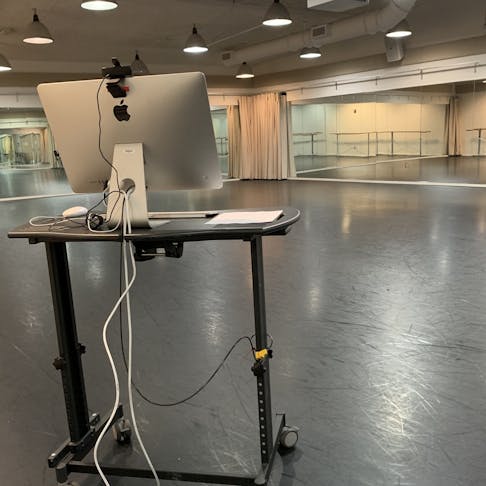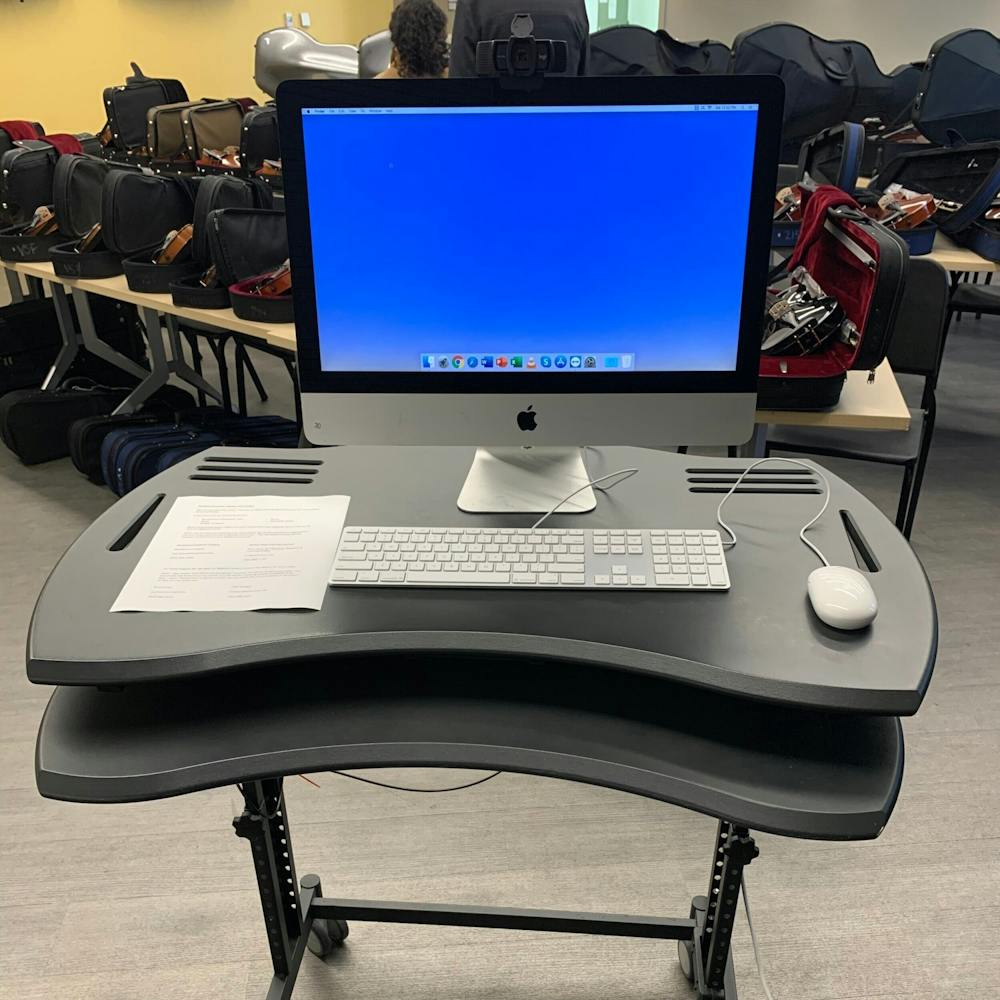Editor’s note: This article originally appeared on theeaglecoronavirusproject.com, a separate website created by Eagle staff at the onset of the coronavirus pandemic in spring 2020. Articles from that website have been migrated to The Eagle’s main site and backdated with the dates they were originally published in order to allow readers to access them more easily.
The Life section is publishing a series of stories highlighting how the cancellation of classes due to the coronavirus is specifically affecting arts classes.
While classes across the University experiment with platforms like Zoom and Blackboard Collaborate for online learning, performing arts students at AU have a different set of challenges to navigate. For students pursuing theatre, dance, music and audio technology within the Department of Performing Arts, many classes need to be completely restructured.
When AU moved classes online, College of Arts and Sciences Dean Peter Starr, Department of Performing Arts Chair E. Andrew Taylor, the associate deans, the heads of all arts departments, and professors were assigned to a “task force” to formulate plans. At first they were hopeful that some performances could still happen, according to Daniel Abraham, the director of AU Chamber Singers. After in-person classes were suspended for the rest of the semester in March, that hope disappeared.
The faculty task force considered how different categories of classes would operate online: traditional classes, performance-focused classes and ensembles/productions. Each discipline has a different set of challenges when it comes to teaching and learning, Taylor said. All programs want to provide different options for their students during this time.
“In each case, we can’t actually deliver the full experience and value of an in-person class online,” Taylor said. “But, we can rethink what and how we teach as best as we can.”
Junior CLEG major and theatre minor Rachel Abraham said her arts professors have been understanding. According to Abraham, her other professors are attempting to function business as usual — posting lectures and assigning big group projects.
“We are in an international pandemic and things aren’t business as usual, so like, at the bare minimum, arts professors are being more accommodating, which I appreciate,” Abraham said.
In her Theatre History class, her professor, Karl Kippola, opened up a dialogue for his students to share their thoughts on how this transition is going for them, through a discussion board on Blackboard and through 30-second check-ins with each student at the beginning of every Zoom class period.
Due to these conversations, syllabi for the rest of the semester were reassessed. Daniel Abraham said that he had concerns about his Music History class completing research studies, which began in January. He allowed his students to explore different options in generating a final project, including webpages and apps to present their findings.
“We’re working on finding ways around that and being creative with what their final products might be,” he said. “It doesn’t necessarily, for my course, need to be a formal paper. It provides challenges and motivations for ingenuity and inventions in this case.”

The dance studio is set up with a media workstation for AU dance instructors to teach with. (Photo courtesy of E. Andrew Taylor)
Performance-based and hands-on classes: how do you create art online?
Professors of performance-based classes developed media workstations with built-in Zoom accounts, mobile video cameras and desktop computers. They were placed in the dance studio, the Katzen Studio Theatre and a classroom, because some members of the dance faculty don’t have access to a studio at home. With the D.C. stay-at-home order, teaching distance learning courses is an essential function.
Dance program director Britta Joy Peterson previously taught online classes at Cowles Center for Dance and the Performing Arts. She said she knows her faculty well enough to address their teaching needs, including access to technology and limiting who would enter the studio to create a safe teaching environment.
“Some people assume that computers and the Internet are a given, and that is not true,” Peterson said. “Frankly, it’s a very privileged position to think that.”
In reframing dance classes online, Peterson asked her faculty to translate their course material in a way that was high quality for the students and sustainable for their lives. Some use Blackboard Collaborate, some use Zoom and some teach live on Instagram. The dance program provided online resources for students to take virtual dance classes and view online performances.
According to Peterson, on all platforms, disruption of class flow because of Internet connection and working with recorded sound is difficult. The weirdest part is not getting a reaction from students.
“It feels like performance,” Peterson said. “When you’re speaking on these things to students, you’re performing with no energetic response because everyone is muted.”
The loss of in-person classes also means Peterson can’t teach partnering or ensemble skills. She said she and the rest of the embodied knowledge (dance technique, movement forms and somatics) teachers feel good about the work they’re doing, but they’re grieving the loss of the daily practice.
Online acting classes present a different challenge. Professor Carl Menninger’s first reaction to the move to online classes was anger and disappointment, but understanding that the University was acting responsibly. His second thought was, “How the hell am I going to teach acting?”
Once he was able to rethink his Scene Study course, Menninger got excited. Instead of starting classes with physical warmups, he now starts the class with check-ins with every student. Rather than doing partner scenes like they would in person, students wrote and performed original monologues from the point of view of their characters. Another assignment involved asking people over 35 to tell a funny story and acting out the story as their character.
“I was so impressed with the writing; it went way beyond the expectations of what I thought it would be,” Menninger said. “I think what’s nice is that all of the faculty, we’re approaching things so differently, so if you’re taking multiple theater classes, you’re getting a very different experience from each professor.”
Sophomore musical theater and public relations major Emma Dorsch wrote her monologue from the point of view of Amanda from “The Glass Menagerie,” during a moment when Amanda was washing dishes and talking to her son while eavesdropping on her daughter in the other room. She performed it in her kitchen and actually washed dishes.
“A lot of people I know got really creative with their assignments and took advantage of the situation, which was really fun to see,” Dorsch said. “In the Studio [Theatre], I would’ve pretended to wash dishes, but being in an even more realistic setting was very helpful.”
For the audio production and technology programs, which require hands-on work in a studio environment, their biggest loss is the closing of the Kreeger recording studios.
“That’s what [students] come here for. They come to AU to use the recording studios, they come to get their hands on all this gear and be in this environment where they can trust that what they’re hearing is accurate,” said Matt Twiford, an audio production professor.
The faculty moved to using demonstrations for their courses. According to Twiford, he and a colleague went into the recording studios, before Mayor Muriel Bowser shut down D.C., and took DSLR videos of them using the equipment in the studios to give their students as close to the real experience as possible.
The audio production program ended up rethinking the focus of its courses. Instead of recording with bands in the studios, Twiford’s Sound Studio Techniques I course is now using free platforms like Pro Tools and iZotope for post-production and film work, since students will have more time for studio recording in Sound Studio Techniques II.
“I'm fairly content with the structure of my online Sound Studio I class as the ATEC professors are going above and beyond to make the most out of the course,” said sophomore audio production major Nicolette Kelly. “I feel I am still learning valuable material in my class.”
Ensembles: how do you make art together without in-person interaction?
The music faculty assessed each ensemble’s progress for completing the required amount of contact hours for credit, according to professor Daniel Abraham. Ensembles that still needed to fulfill those hours are the most difficult courses to translate digitally. Abraham looked into options for real-time collaboration software, including ArtsMesh, which he found to be too technically involved.
Jazz Combo Director Josh Bayer is now doing improvisation coaching online, individually or in small groups, for his musicians to fulfill the ensemble credit. The five members of Jazz Combo are also doing as many recording projects as they can since they can’t perform their concerts. Bayer is planning on hosting a watch party and allowing his musicians to send the recordings out to anyone who wants to listen.
Although Big Band, Bayer’s jazz orchestra, had enough contact hours to fulfill ensemble credit, Bayer still offers drop-in improv sessions for whoever wants to come in and play during the ensemble’s scheduled rehearsal time. For all sessions, he uses an online music notation system called MuseScore.
Typically, he and his student have MuseScore open at the same time. Bayer plays a progression and the student then plays to it on their instrument. On the sheet music, he writes out exercises, songs and performance notes.
“I’m using it as a chalkboard and as a performance tool,” Bayer said. “It’s working out okay. It wasn’t meant to be a chalkboard, but we’re kind of faking it to the best of our ability.”
He also uses Microsoft Paint to show chords and fingering patterns to guitar students. Bayer draws templates himself and moves elements around.
“Some of this crap I’ve never done before digitally,” he said. “I prefer to do it by hand; when the student is there, I have them do it, because the more senses used, the more something stays with you cognitively.”
Despite completing the required rehearsal hours for credit, Daniel Abraham didn’t want to leave Chamber Singers without a sense of closure. He planned Zoom meetings for his singers to discuss future plans and honor seniors, especially those who’ve sung with the ensemble for all four years of college.
“Ensembles aren’t just about learning and performing music, they’re also about the social aspects of being in a community together and that’s something I’m striving to continue,” Abraham said.
For some, the move to online opened up new opportunities for collaboration.
After the first online class period, Matt Twiford realized that his students needed collaboration. He decided to prioritize a collaborative mixing assignment he had saved for later in the semester. Twiford encouraged pairs to have rough drafts of their two-tracks of Digital Audio Workstation sessions and share those demos back and forth using Google Drive, Dropbox or iCloud. The class is currently doing a larger sound design group project.
“Although I was hesitant at first, I think it is great to have a classmate to bounce ideas off of for the project and really get creative with it,” sophomore Nicolette Kelly said. “I think this will be a very challenging but fun project, and I can't wait to see what my classmates create!”
Due to the move to online learning, the AU Dance Company can no longer perform as one ensemble. The theme of their final performance, “How does dance work beyond the studio and the stage?” became more relevant after the transition online.
Dancers turned their performances into two two-and-a-half minute solos, which they presented via Zoom, Peterson said. The dance program will release these solos, along with other interviews and reflections from the students, on social media.
Peterson wants her students to recognize the importance of practice.
“If the performance is the pinnacle, then you’ve forgotten the point of this. How do you share your practice daily? How is the process alive in every minute that you move through your world?” she said.

An example of how music professor Josh Bayer conducts his private lessons and improvisation sessions using MuseScore.
Individual work: being face-to-face from miles away
Some professors use Google Hangouts or FaceTime for individual work. Peterson, who offers phone numbers to her students, said that’s not something she normally does.
“Your emails might get lost, so you have permission to text me and call me because you are my priority and these are not average times,” she said.
For private lessons, the music faculty moved towards using Zoom and Skype for one-on-one sessions, but instructors often struggle with volume issues, Abraham said.
Bayer uses one camera to teach private lessons over Zoom and another as a keyboard camera. He can’t play as much as he usually does with his students, but he strums along on a guitar that’s not plugged into an amp to feel more involved.
“It’s hard seeing people’s hands when you teach,” Bayer said. “I don’t get to walk around my students and check [their] posture. I teach guitar standing up so I can look on both sides of the neck and be very mobile. That has been very frustrating.”
The biggest challenge with private lessons, according to Abraham, was re-assessing how to conduct juries, the final examinations for private students where a student sings or plays in front of a panel, not including their teacher, for a separate adjudicated grade.
Graduate arts management student Abigail Berman stepped up to spearhead the project of adapting the DPA’s system for program auditions, SlideRoom, to include a new module for juries. Students will be able to upload their jury exams for a panel to view.
In addition, senior recitals had to be rethought, and students were given a “palate of options,” Abraham said. Some could postpone their recital and receive an incomplete, or mutate the recital into a more lecture recital or more research-based product that would fulfill the interests and outcomes of the course.
“Each student who's involved in preparing a recital, we’re basically approaching individually to make decisions and adjustments on a case of each individual performer and trying to figure out what’s right for them as they move into their career,” Abraham said.
Finding hope in a changing world of arts education
Even as students and faculty have gotten into the swing of things with classes, many still mourn the loss of performances and proper farewells. But at this point in the semester, most students understand there isn’t another option. Peterson believes that during this time artists can learn discipline, resilience, self-responsibility, rigor, and the value of technology and the Internet.
“It is very difficult to pretend things are normal when they are not,” Peterson said. “And I think that’s something that I’m trying in my own practice to work through.”
Peterson said she is also deeply concerned about recruitment and retention, especially since the dance program changed its course prefix to be “DNCE,” rather than “PERF,” for fall 2020.
For now, DPA Chair E. Andrew Taylor believes that students can still learn from this experience, despite wrestling with the unknown and not being able to learn their discipline as fully as they can.
“While we can’t teach or perform as we would have liked, this is absolutely an ongoing lesson into what a performing artist is and does. You work with what you’re given and you make it beautiful as best you can,” Taylor said.





